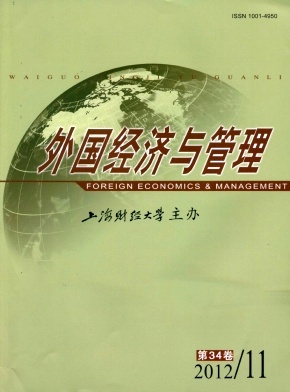比较管理研究范式比较、整合及应用问题探讨与未来研究展望
外国经济与管理 2012 年 第 34 卷第 11 期, 页码:72 - 81
摘要
参考文献
摘要
通过比较分析四种经典比较管理研究范式,发现它们普遍存在以下问题:对研究对象缺乏统一的界定;强调比较管理研究的解释性特点有余而关注管理移植问题不足;管理情境分析流于片面,没有深入探讨研究范式的具体应用问题。基于此,本文从比较管理研究的目的和基本问题入手,对比较管理研究的对象、管理情境、管理有效性、对策性研究在比较管理研究中的地位等关键问题进行了重新阐释,进而提出了比较管理整合研究范式,并从研究路线、可操作化和多学科融合三个方面探讨了整合范式的应用问题;最后在指出本研究的认识意义以后对未来比较管理研究进行了简要的展望。
[1]Adler N.Understanding the ways of understanding:Cross-cultural management methodology reviewed[J].International Comparative management,1984,(4/1):31-67.
[2]Babbie E.The practice of social research[M].(12th Ed.).Belmont:Wadsworth Publishing Co Inc,2009:231.
[3]Deal T E and Kennedy A A.Corporate cultures:The rites and rituals of corporate life[M].New Jersey:Addison-Wesley,1982.
[4]Deal T E and Kennedy A A.Corporate cultures[M].New York:Basic Books,2000.
[5]Farmer R N and Richman B M.A model for research in com-parative management[J].California Management Review,1964,7(2):55-68.
[6]Farmer R N and Richman B M.Comparative management and economic progress[M].Homewood:Richard D.Irwin,1965.
[7]Harbison F and Myers C A.Management in the industrial world:An international analysis[M].New York:McGraw-Hill,1959.
[8]Hodgson G.Evolutionary and competence-based theories of the firm[J].Journal of Economic Studies,1998,25(1):25-26.
[9]Hofstede G.Culture’s consequences:Comparing values,be-haviors,institution,and organizations across nations[M].London:Sage Publication,1980:24-31.
[10]Kaplan R S and Norton D P.The balanced scorecard-meas-ures that drive performance[J].Harvard Business Review,1992,70(1):69-97.
[11]Kaplan R S and Norton D P.Using the balanced scorecard as a strategic management system[J].Harvard Business Re-view,1996,74(1):75-86.
[12]Koontz H.A model for analyzing the universality and trans-ferability of management[J].Academy of Management Jour-nal,1969,12(4):415-429
[13]Koontz H,et al.Management[M].(8th Ed.).Auckland:McGraw-Hill,1984:15-35.
[14]Kuhn T S.The structure of scientific revolutions[M].Chica-go:University of Chicago Press,1962:43-51.
[15]Masahiko Aoki.Toward an economic model of the Japanese firm[J].Journal of Economic Literature,1990,28(1):1-27.
[16]Masahiko Aoki.Toward a comparative institutional analysis[M].Massachusetts:MIT Press,2001.
[17]Negandhi A R and Estafen B S.A research model to deter-mine the applicability of American management know-how in differing cultures and/or environments[J].Academy of Management Journal,1965,8(4):309-318.
[18]Negandhi A R and Prasad B S.Comparative management[M].New York:Appleton-Century-Crofts,1971:7-25.
[19]Negandhi A R.Comparative management and organization theory:A marriage needed[J].Academy of Management Journal,1975,18(2):334-344.
[20]Nelson R R and Winter S G.Evolutionary theorizing in eco-nomics[J].Journal of Economic Perspectives,2002,16(2):23-46.
[21]Ouchi W G.Theory Z:How American business can meet the Japanese challenge[M].New York:The Free Press,1981:71-230.
[21]Pascale R T and Athos A G.The art of Japanese manage-ment:Applications for American executives[M].New York:Warner Books,1981:1-363.
[22]Peters T J and Waterman R H.In search of excellence:Les-sons from America's best-run companies[M].New York:Warner Books,1982.
[23]Porter M E.How competitive forces shape strategy[J].Harvard Business Review,1979,57(2):87-97.
[24]Porter M E.Competitive strategy[M].New York:The Free Press,1980:4.
[25]Schein E H.Organizational culture and leadership[M].San Francisco:Jossey-Bass,1992:189-202.
[26]Schollhammer H.The comparative management theory jun-gle[J].Academy of Management Journal,1969,12(1):81-97.
[27]Scott R W.Institutions and organizations[M].Thousand Okks:Sage Publications,1995.
[28]Witt U.Imagination and Leadership:The neglected dimen-sion of an evolutionary theory of the firm[J].Journal of E-conomic Behavior and Organization,1998,35(1):161-177.
[29]曹德骏.比较管理学科的发展问题[J].比较管理,2010,(2):12-22.
[30]高闯,关鑫.比较管理的研究对象与边界[J].中国工业经济,2010,(12):138-148.
[31]黄群慧.比较管理学的理论模式研究[J].外国经济与管理,1991,(1):31-35.
[32]杨海涛.比较管理学导论[M].南昌:江西人民出版社,1988.
[2]Babbie E.The practice of social research[M].(12th Ed.).Belmont:Wadsworth Publishing Co Inc,2009:231.
[3]Deal T E and Kennedy A A.Corporate cultures:The rites and rituals of corporate life[M].New Jersey:Addison-Wesley,1982.
[4]Deal T E and Kennedy A A.Corporate cultures[M].New York:Basic Books,2000.
[5]Farmer R N and Richman B M.A model for research in com-parative management[J].California Management Review,1964,7(2):55-68.
[6]Farmer R N and Richman B M.Comparative management and economic progress[M].Homewood:Richard D.Irwin,1965.
[7]Harbison F and Myers C A.Management in the industrial world:An international analysis[M].New York:McGraw-Hill,1959.
[8]Hodgson G.Evolutionary and competence-based theories of the firm[J].Journal of Economic Studies,1998,25(1):25-26.
[9]Hofstede G.Culture’s consequences:Comparing values,be-haviors,institution,and organizations across nations[M].London:Sage Publication,1980:24-31.
[10]Kaplan R S and Norton D P.The balanced scorecard-meas-ures that drive performance[J].Harvard Business Review,1992,70(1):69-97.
[11]Kaplan R S and Norton D P.Using the balanced scorecard as a strategic management system[J].Harvard Business Re-view,1996,74(1):75-86.
[12]Koontz H.A model for analyzing the universality and trans-ferability of management[J].Academy of Management Jour-nal,1969,12(4):415-429
[13]Koontz H,et al.Management[M].(8th Ed.).Auckland:McGraw-Hill,1984:15-35.
[14]Kuhn T S.The structure of scientific revolutions[M].Chica-go:University of Chicago Press,1962:43-51.
[15]Masahiko Aoki.Toward an economic model of the Japanese firm[J].Journal of Economic Literature,1990,28(1):1-27.
[16]Masahiko Aoki.Toward a comparative institutional analysis[M].Massachusetts:MIT Press,2001.
[17]Negandhi A R and Estafen B S.A research model to deter-mine the applicability of American management know-how in differing cultures and/or environments[J].Academy of Management Journal,1965,8(4):309-318.
[18]Negandhi A R and Prasad B S.Comparative management[M].New York:Appleton-Century-Crofts,1971:7-25.
[19]Negandhi A R.Comparative management and organization theory:A marriage needed[J].Academy of Management Journal,1975,18(2):334-344.
[20]Nelson R R and Winter S G.Evolutionary theorizing in eco-nomics[J].Journal of Economic Perspectives,2002,16(2):23-46.
[21]Ouchi W G.Theory Z:How American business can meet the Japanese challenge[M].New York:The Free Press,1981:71-230.
[21]Pascale R T and Athos A G.The art of Japanese manage-ment:Applications for American executives[M].New York:Warner Books,1981:1-363.
[22]Peters T J and Waterman R H.In search of excellence:Les-sons from America's best-run companies[M].New York:Warner Books,1982.
[23]Porter M E.How competitive forces shape strategy[J].Harvard Business Review,1979,57(2):87-97.
[24]Porter M E.Competitive strategy[M].New York:The Free Press,1980:4.
[25]Schein E H.Organizational culture and leadership[M].San Francisco:Jossey-Bass,1992:189-202.
[26]Schollhammer H.The comparative management theory jun-gle[J].Academy of Management Journal,1969,12(1):81-97.
[27]Scott R W.Institutions and organizations[M].Thousand Okks:Sage Publications,1995.
[28]Witt U.Imagination and Leadership:The neglected dimen-sion of an evolutionary theory of the firm[J].Journal of E-conomic Behavior and Organization,1998,35(1):161-177.
[29]曹德骏.比较管理学科的发展问题[J].比较管理,2010,(2):12-22.
[30]高闯,关鑫.比较管理的研究对象与边界[J].中国工业经济,2010,(12):138-148.
[31]黄群慧.比较管理学的理论模式研究[J].外国经济与管理,1991,(1):31-35.
[32]杨海涛.比较管理学导论[M].南昌:江西人民出版社,1988.
引用本文
刘涛. 比较管理研究范式比较、整合及应用问题探讨与未来研究展望[J]. 外国经济与管理, 2012, 34(11): 72–81.
导出参考文献,格式为:
下一篇:创业能力研究现状探析与未来展望





 7654
7654  496
496

